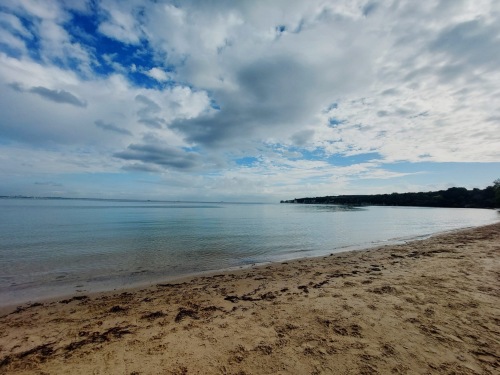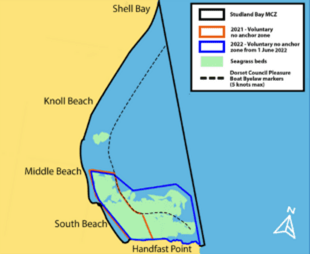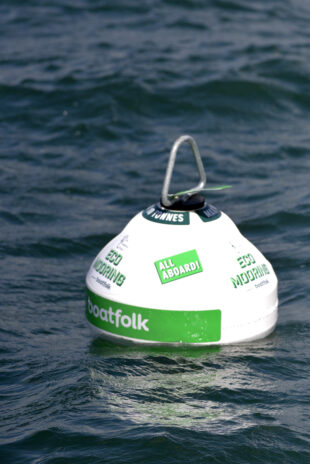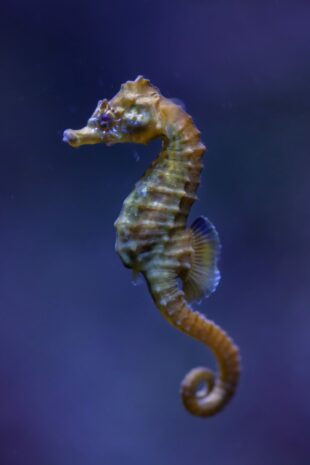It was great to see coverage of the conservation efforts at Studland Bay on BBC’s Springwatch programme (episode 7) recently. The show, which aired on 7 June, highlighted the need to protect the area’s precious seagrass – home to protected species of seahorse - and promoted the use of eco-moorings for recreational vessels.
In this blog, Marine Management Organisation (MMO), share more information about the area’s voluntary no-anchor zone and some guidance on how to help protect the seagrass, including the use of eco-moorings, and the seahorses and other wildlife that live there.

Studland Bay lies on the stunning Dorset coastline, best known for its iconic chalk formations, Old Harry Rocks. It is a popular destination for boating, kayaking and other recreational activities due to the spectacular views and safety of the bay.
What many visitors may not realise is that under the water is an important habitat of seagrass beds which supports protected species of seahorse and other wildlife.
These beautiful creatures are a rare sight - something which may make you feel compelled to seek them out. However, if you’re considering looking for seahorses or wish to photograph them – be aware!
The long-snouted, or spiny, seahorse (Hippocampus Guttulatus) found at Studland Bay is protected under the Wildlife and Countryside Act 1981. This means it is an offence to disturb, capture, injure or kill a seahorse, or to damage or destroy their habitat.
For those planning any activity that’s likely to disturb seahorses or their habitat – such as photography, filming or scientific or educational research – you must have a wildlife licence from MMO, or risk committing an offence.
If you’re snorkelling around the seagrass beds, it’s important you make sure the seagrass and seahorses are not harmed or disturbed by ensuring any equipment or clothing is tucked away and your arms and legs do not dangle down onto or drag through the seagrass.
So, as tempting as it may be to try and spot a seahorse, we recommend following best practice when diving in seagrass and be aware of the sensitive species that it supports, or avoiding their habitat entirely, letting these shy creatures enjoy their homes so that they can thrive.
What we’re doing to help
Working with Studland Bay Marine Partnership (SBMP), MMO has supported the development of initiatives to help protect the seagrass, both for now and the future, while ensuring that marine activities can continue in a sustainable way.
 Studland Bay is now a Marine Conservation Zone (MCZ), designated for four protected features, including the seagrass bed and long-snouted seahorse. There is also a voluntary no anchor zone in place in the bay located off South Beach out to Old Harry Rocks, which aims to protect the seagrass habitat from damage caused by the dropping and weighing of anchors.
Studland Bay is now a Marine Conservation Zone (MCZ), designated for four protected features, including the seagrass bed and long-snouted seahorse. There is also a voluntary no anchor zone in place in the bay located off South Beach out to Old Harry Rocks, which aims to protect the seagrass habitat from damage caused by the dropping and weighing of anchors.
Just this week, we published a review of the voluntary no anchor zone which looks at last year’s activities, stakeholder feedback and activity monitoring data, to help understand how this intervention is protecting Studland Bay’s precious seagrass habitats and rare species of seahorse, pipefish and rays. Read the 2022 Review on gov.uk.
What you can you to help
Join other visitors to the area and members of the local boating community who have already made positive changes to help protect the seagrass at Studland Bay by considering the following:

- Avoid anchoring in seagrass beds located off South Beach out to Old Harry Rocks - we recognise that this area is an important safety refuge for vessels and safety of life at sea will always come first so everyone has the right to anchor in an emergency within Studland Bay
- Take care when moving in the nearshore area of South Beach as seagrass beds are the breeding areas for legally protected long snouted seahorses may be disturbed
- Use one of the eco-moorings in the area – as shown in the BBC Springwatch feature, the special design of the moorings, using a helical screw and elastic cord, allow boating to continue without damaging the seagrass beds
- If you’re visiting Studland this boating season, check the voluntary no anchor zone coordinates.
The spiny seahorse
If you do encounter a seahorse, here are some pointers to reduce any potential disturbance:
- Do not pursue seahorses if they swim away
- If a seahorse displays signs of distress you must retreat slowly to at least 5 metres away, avoiding sudden movement.
The following list describes typical behaviour displayed by stressed seahorses:
- Rise up into the water column above the seabed or into surrounding area and swim with its tail curled up
- Hold its head in a downward, chest hugging posture
- Turn its back, curl up, lie flat or move away
- Its colouring will darken, especially in the squares amongst the body ridges
- The pupils in the eyes of the seahorse will dilate/fluctuate.
Read MMO’s full guidance on Seahorses on gov.uk.

2 comments
Comment by Sailor Jim posted on
Whilst I am no greater lover of the MCZ because it impacts very negatively on the long cherished enjoyment of Studland Bay, I do understand the argument for protection of the underwater habitat.
The voluntary no-anchor zone is clearly not working. On Saturday 24th June 2023 there were a considerable number (dozens) of boats entirely of the motor boat/RIB variety anchored in the MCZ. Whether they were ignorant of the exclusion zone or not bothered I do not know, but suspect the latter as the MCZ has been widely advertised.
How is this going to play out ?
Comment by David Patrick, Digital Communications Manager posted on
Hi Jim, we are sorry to hear that you have spotted a number of boaters not complying with the VNAZ. Our management approach has very much been focused on informing and educating, as well as working with local partners to raise awareness, where possible to achieve positive behaviour change. This has included supporting initiatives which offer boaters suitable sustainable alternatives to anchoring in the VNAZ, such as the eco-mooring which are being delivered by the Studland Bay Marine Partnership. There is no intention to introduce statutory measures and enforcement, however MMO will continue
monitor the effectiveness of the voluntary approach as well as activity levels through this current boating season and next year.